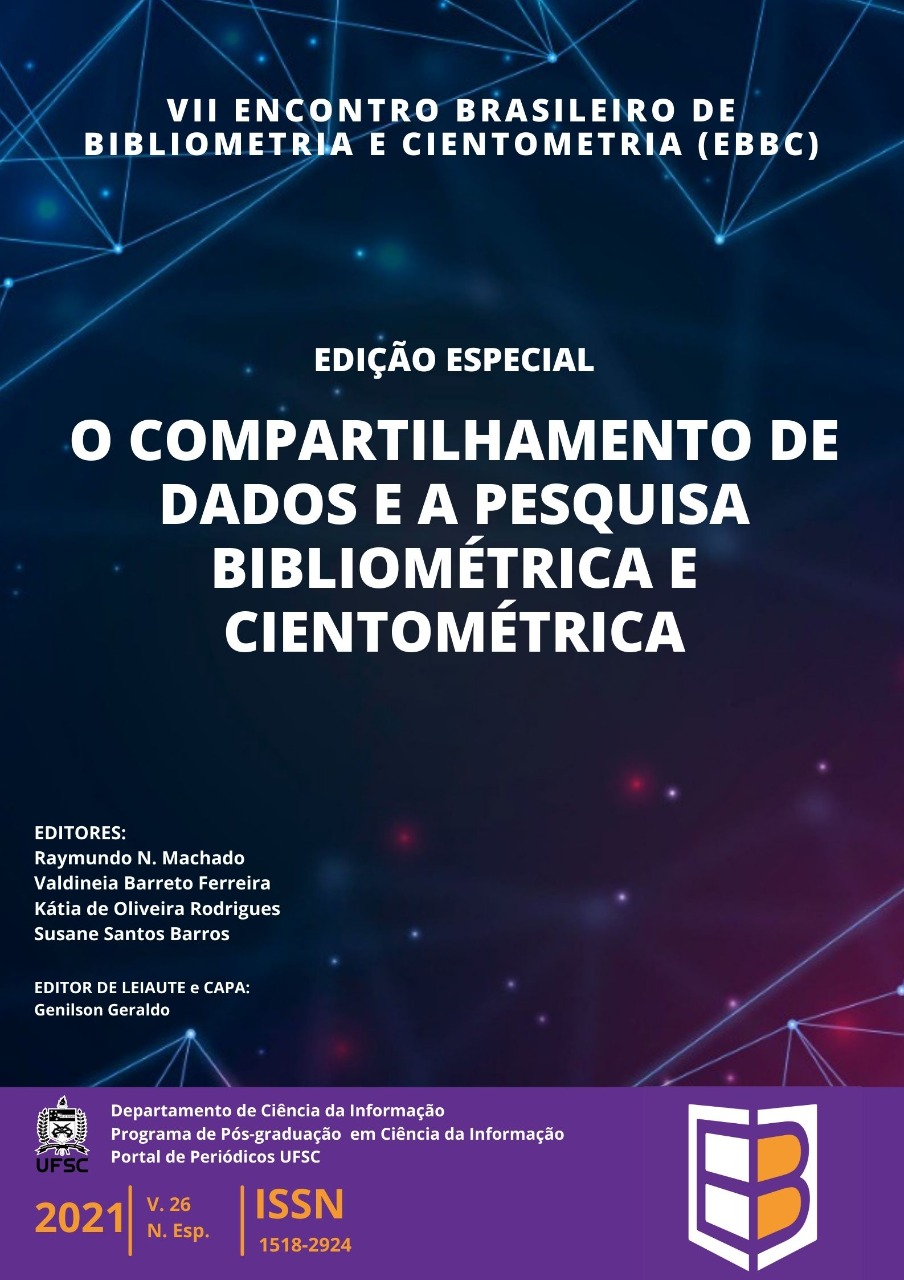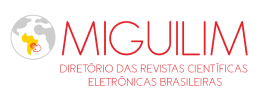Scientific Production of Productivity Fellows In Information Science about Human–Computer Interaction
DOI:
https://doi.org/10.5007/1518-2924.2021.78803Keywords:
Scientific production, Human-computer interaction, Indicators in science and technology, Productivity fellowsAbstract
Objective: to characterize the scientific production in Human-Computer Interaction (HCI) of productivity fellows in Information Science in Brazil (PQ-CI-CNPq).
Method: it used bibliometric techniques to characterize the universe of 53 articles published by the PQ-CI-CNPq on Human-Computer Interaction.
Result: it presents how themes related to the HCI domain were explored by the scientific community of PQs in Information Science. Among the results, the data obtained indicate that publications on this topic appear from 2001, without publications in the 1990s; studies in “information architecture”, which is the most used keyword in the analyzed articles, stand out in the HCI domain in Information Science, and; there is a prominent influence of the authors Morville and Rosenfeld on the publications.
Conclusions: the journals chosen to publish on this topic are mostly well qualified by Capes, and this fact may attest to the quality of the production, due to the seriousness and legitimacy of the journals in which such a production is published. It seems that the HSI had information architecture as the most representative theme in the scope of CI, among the PQ-CI-CNPq, which can be considered as a basic theme in this universe and that offers theoretical and practical support to other concepts and applications, which have also been studied such as usability, accessibility, and findability.
Downloads
References
ALBERGARIA, E. T.; BAX, M. P.; PRATES, R. O. Interação Humano Computador na Ciência da Informação. In: Encontro Nacional de Pesquisa em Ciência da Informação, 14., 2013, Florianópolis. Anais eletrônicos [...]. Florianópolis: Universidade Federal de Santa Catarina, 2013.
ALBUQUERQUE, A. R. R.; LIMA-MARQUES, M. Sobre os fundamentos da Arquitetura da Informação. Perspectivas em Gestão & Conhecimento, João Pessoa, v. 1, p. 60-72, 2011.
ANDRAOS, J. Scientific genealogies of physical and mechanistic organic chemists. Canadian Journal of Chemistry, [s. l.], v. 83, n. 9, p. 1400-1414, 2005.
ARAÚJO, C. A. A. Correntes Teóricas da Ciência da informação. Ciência da Informação, Brasília, DF, v. 38, n.3, p. 192-204, set./dez. 2009.
ASSOCIAÇÃO BRASILEIRA DE NORMAS TÉCNICAS. NBR 9241-11. Requisitos Ergonômicos para Trabalho de Escritórios com Computadores. Parte 11 – Orientações sobre Usabilidade. Rio de Janeiro: ABNT, 2002.
BARBOSA, S. D.J.; SILVEIRA, M. S.; GASPARINI, I. What publications metadata tell us about the evolution of a scientific community: the case of the brazilian human: computer interaction conference series. Scientometrics, [s. l.], v. 110, n. 1, p. 275-300, out. 2016. Disponível em: http://dx.doi.org/10.1007/s11192-016-2162-4.
BARTNECK, C.; HU, J. Scientometric analysis of the CHI proceedings. In: INTERNATIONAL CONFERENCE ON HUMAN FACTORS IN COMPUTING SYSTEMS, 27., 2009. Proceedings [...]. [s. l.]: ACM Press, 2009. p. 699-708. Disponível em: http://dx.doi.org/10.1145/1518701.1518810
BRASIL. Lei 13.146 de 06 de julho de 2015. Institui a lei brasileira de inclusão da pessoa com deficiência (estatuto da pessoa com deficiência). Brasília, DF: Presidência da República, 2015. Disponível em: http://www.planalto.gov.br/ccivil_03/_Ato2015-2018/2015/Lei/L13146.htm. Acesso em: 3 ago. 2021.
BOURDIEU. P. O campo científico. In: ORTIZ, Renato (org.). Pierre Bourdieu: Sociologia. São Paulo: Ática, 1983. p. 122- 155.
CAMARGO, L. S. A. Metodologia de desenvolvimento de ambientes informacionais digitais a partir dos princípios da arquitetura da informação. 2010. Tese (Doutorado em Ciência da Informação) – Universidade Estadual Paulista Júlio de Mesquita Filho, Marília, 2010.
CAMARGO, L. S. A.; VIDOTTI, S. A. B. G. Arquitetura da informação: uma abordagem prática para o tratamento de conteúdo e interface em ambientes informacionais digitais. Rio de Janeiro: LTC, 2011.
CARD, S. K. et al. Readings in Information Visualization: Using Vision to Think. Morgan Kaufmann Series in Interactive Technologies, Academic Press, 1999.
CONSELHO NACIONAL DE DESENVOLVIMENTO CIENTÍFICO E TECNOLÓGICO. Criação. 2018. Disponível em: http://cnpq.br/acriacao/ Acesso em: 20 maio 2020.
COSTA, L. F. da; RAMALHO, F. A. A usabilidade nos estudos de uso da Informação: em cena, usuários e sistemas interativos de informação. Perspectivas em Ciência da Informação, Belo Horizonte, v. 15, n. 1, p. 92-117, jan./abr. 2010.
FREITAS, C. M. D. S. et al. Introdução à Visualização de Informações. RITA, v. 8, n. 2, p.143-158, 2001.
FERNANDES, J. D’ A. P. B. Diagnóstico da acessibilidade informacional na Biblioteconomia brasileira. 2018. Dissertação (Mestrado em Ciência da Informação) – Universidade Federal do Ceará, Fortaleza, 2018. Disponível em: http://www.repositorio.ufc.br/bitstream/riufc/33425/3/2018_dis_jdpbfernandes.pdf. Acesso em: 03 ago. 2021.
GUEDES, M. C.; AZEVEDO, N.; FERREIRA, L. O. A produtividade científica tem sexo? um estudo sobre bolsistas de produtividade do CNPq. Cadernos Pagu, Campinas, n. 45, p. 367-399, 2015.
HENRY, N.; GOODELL, H.; ELMQVIST, N.; FEKETE, J. 20 Years of Four HCI Conferences: a visual exploration. International Journal Of Human-Computer Interaction, [s. l.], v. 23, n. 3, p. 239-285, dez. 2007. Disponível em: http://dx.doi.org/10.1080/10447310701702402. Acesso em: 22 maio 2020.
MALMGREN, R. D.; OTTINO, J. M; AMARAL, L. A. N. The role of mentorship in protege performance. Nature, v. 465, mar. 2010.
MENA-CHALCO, J. P. Genealogia acadêmica: uma ferramenta para investigar a origem, evolução e disseminação de áreas do conhecimento. In: ENCONTRO BRASILEIRO DE BIBLIOMETRIA E CIENTOMETRIA, 5., 2016, São Paulo. Anais [...]. São Paulo: ECA/USP, 2016. v. 1, p. 1-90. Disponível em: https://www.researchgate.net/publication/305082103_Genealogia_academica_uma_ferramenta_para_investigar_a_origem_evolucao_e_disseminacao_de_areas_do_conhecimento?channel=doi&linkId=5781059608ae5f367d392783&showFulltext=true. Acesso em: 20 maio 2020.
MORVILLE, P. Ambient findability. Sebastopol: O’Really, 2005.
MORVILLE, P. ; ROSENFELD, L. Information for Architecture for the Word Wide Web. 3. ed. Sebastopol: O’Reilly, 2006.
NASCIMENTO, H. A. D.; FERREIRA, C. B. R. Uma introdução à visualização de informações. Visualidades, Goiânia, v. 9, n. 2, p. 13-43, dez. 2011.
NIELSEN, J.; LORANGER, H.. Usabilidade na web. Rio de Janeiro: Elsevier, 2007.
OLIVEIRA, H. P. C.. Arquitetura da informação pervasiva: contribuições conceituais. 2014. Tese (Doutorado em Ciência da Informação) − Faculdade de Filosofia e Ciências, Universidade Estadual Paulista Júlio de Mesquita Filho, Marília, 2014.
PREECE, J. et al. Human-Computer Interaction, Addison-Wesley, 1994
ROSENFELD, L.; MORVILLE, P.; ARANGO, J. Information Architecture: for the web and beyond. O’Reilly Media, 4th ed. 2015.
SANTOS JUNIOR, R. L. D. Identificação das principais temáticas de pesquisa ligadas a interação humano-computador discutidas na ciência da informação brasileira. Pesquisa Brasileira em Ciência da Informação e Biblioteconomia, v. 16, n. 1, p. 1-27, 2021. Disponível em: 10.22478/ufpb.1981-0695.2021v16n1.56132 Acesso em: 03 ago. 2021.
URBIZAGÁSTEGUI ALVARADO, R. Guía para estimar una forma de crecimiento linealcon el software SPSS. Universidad de California, Riverside, 2020. Disponível em: https://ucriverside.academia.edu/RubenUrbizagastegui. Acesso em: 11 ago. 2021.
VECHIATO, F. L. Encontrabilidade da informação: contributo para uma conceituação no campo da ciência da informação. 2013. Tese (Doutorado em Ciência da Informação) – Faculdade de Filosofia e Ciências, Universidade Estadual Paulista, Marília, 2013.
VECHIATO, F. L.; VIDOTTI, S. A. B. G. Encontrabilidade da informação: atributos e recomendações para ambientes informacionais digitais. In: ENCONTRO NACIONAL DE PESQUISA E PÓS-GRADUAÇÃO EM CIÊNCIA DA INFORMAÇÃO, 15, 2014, Belo Horizonte. Anais [...] Belo Horizonte: Universidade Federal de Minas Gerais, 2014. Disponível em: http://enancib2014.eci.ufmg.br/documentos/anais/anais-gt8. Acesso em: 15 nov. 2020.
WURMAN, R. S. Ansiedade de Informação 2. 2. ed. São Paulo: Editora de Cultura, 2005.
Published
How to Cite
Issue
Section
License
Copyright (c) 2021 Tatyane Lúcia Cruz, Sandra de Albuquerque Siebra, Fábio Mascarenhas e Silva

This work is licensed under a Creative Commons Attribution 4.0 International License.
The author must guarantee that:
- there is full consensus among all the coauthors in approving the final version of the document and its submission for publication.
- the work is original, and when the work and/or words from other people were used, they were properly acknowledged.
Plagiarism in all of its forms constitutes an unethical publication behavior and is unacceptable. Encontros Bibli has the right to use software or any other method of plagiarism detection.
All manuscripts submitted to Encontros Bibli go through plagiarism and self-plagiarism identification. Plagiarism identified during the evaluation process will result in the filing of the submission. In case plagiarism is identified in a manuscript published in the journal, the Editor-in-Chief will conduct a preliminary investigation and, if necessary, will make a retraction.
This journal, following the recommendations of the Open Source movement, provides full open access to its content. By doing this, the authors keep all of their rights allowing Encontros Bibli to publish and make its articles available to the whole community.
Encontros Bibli content is licensed under a Creative Commons Attribution 4.0 International License.
Any user has the right to:
- Share - copy, download, print or redistribute the material in any medium or format.
- Adapt - remix, transform and build upon the material for any purpose, even commercially.
According to the following terms:
- Attribution - You must give appropriate credit, provide a link to the license, and indicate if changes were made. You may do so in any reasonable manner, but not in any way that suggests the licensor endorses you or your use.
- No additional restrictions - You may not apply legal terms or technological measures that legally restrict others from doing anything that the license permits.

























